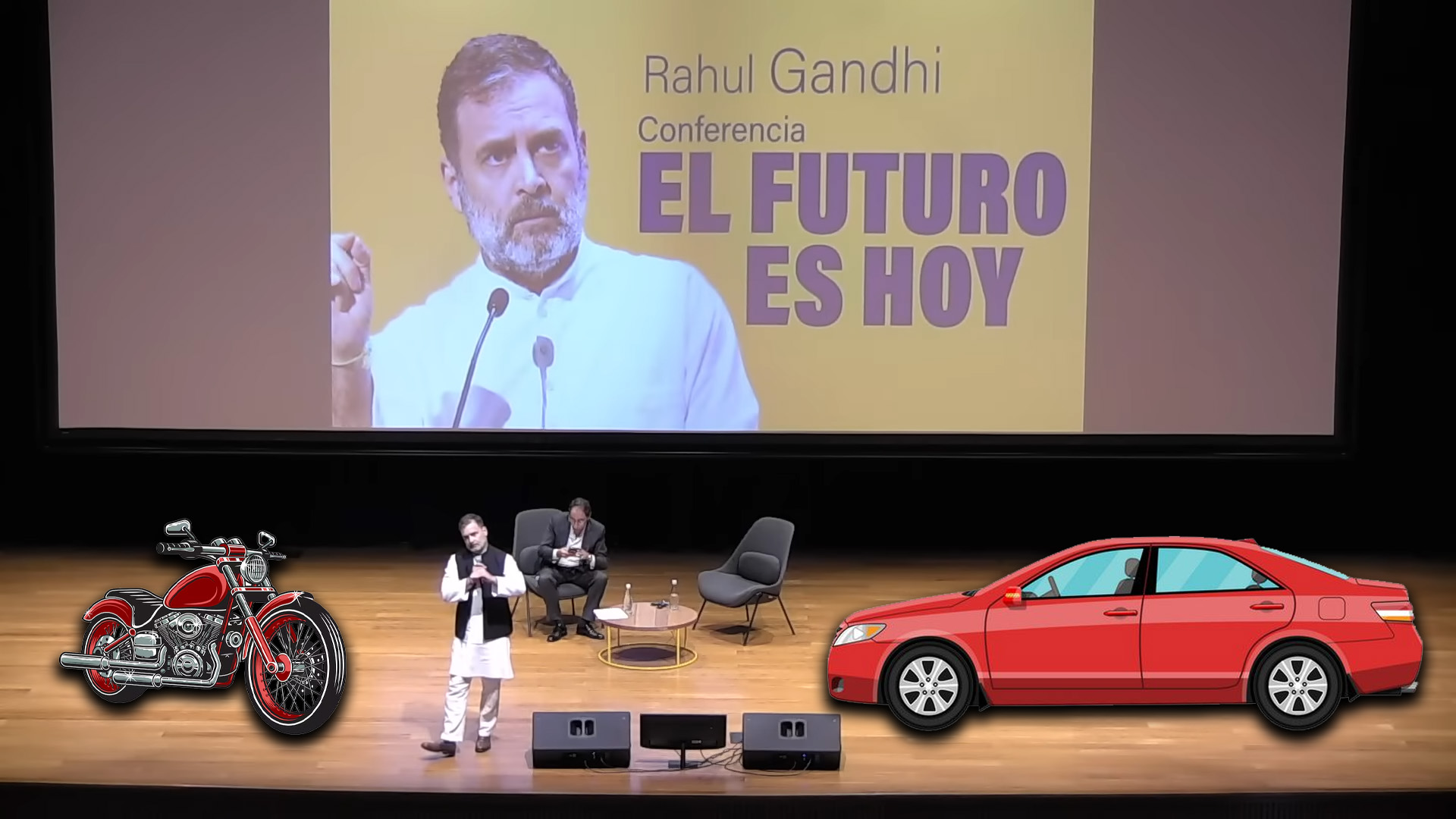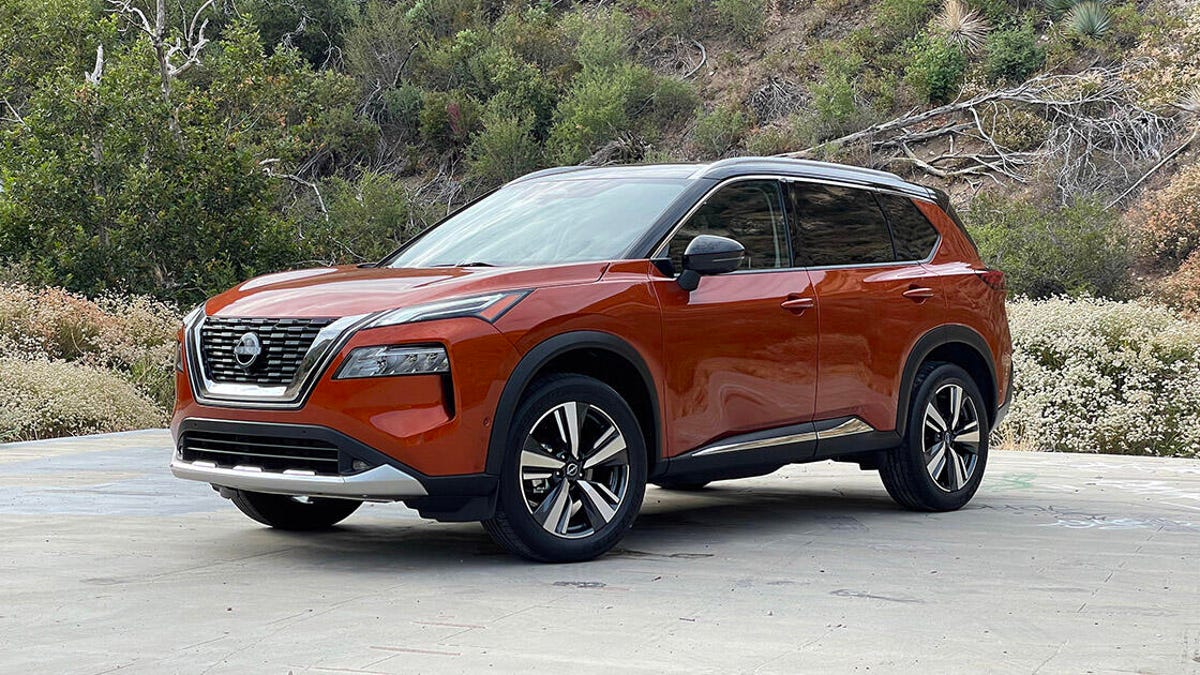Rahul Gandhi claims cars are heavier than motorcycles to protect the driver from the engine: How is entire claim is absurd and defies logic
During is ongoing trip to Colombia, Rahul Gandhi in his speech at EIA University in Envigado made some bizarre claims about cars and motorcycles, inviting ridicule from BJP and netizens. He tried to explain ‘decentralisation’ by using several claims about vehicle engineering, crash safety, and the advantages of electric motors, using comparisons between cars and motorcycles to illustrate his points. Rahul Gandhi first asked why cars are much heavier at 3000 kg while the weight of a motorcycle is just 100 kg. He asked, “To carry one passenger, you need 3,000 kg of metal in a car, while a 100-kg motorcycle carries two passengers. So why is a motorcycle able to carry two passengers with 150 kg of metal and a car needs 3,000?” Then he went on to answer himself, claiming that cars are heavier to prevent the engine from crushing the driver in case of an accident, while the motorcycle engine simply detaches from the vehicle in such a situation. He said, “In a motorcycle, when you have an impact, the engine is separated from you. So, the engine doesn’t hurt you. In a car, when you have an impact, the engine comes into the car. So, the car is designed to stop the engine from killing you.” I haven’t heard this much gibberish in one go. If anyone can decode what Rahul Gandhi is trying to say here, I would be glad to be enlightened. But if you are as amused as I am, rest assured, you are not alone! pic.twitter.com/DlECPO0tcU— Amit Malviya (@amitmalviya) October 2, 2025 He then suggested that electric cars ‘solve this problem’ by having multiple motors. He said, “The electric motor allows you to put a motor there, and there, and there. So, the electric motor is a decentralisation of power. That’s really its effectiveness.” Rahul Gandhi and his supporters may believe this is some very logical explanation, but the fact is, every claim made by the Congress leader is meaningless, or as BJP calls it, ‘gibberish’. Here is why. The weight First, while there are obvious differences in the weight of 4 wheelers and 2 wheelers, Gandhi exaggerated it too much. He claimed that a typical car requires 3,000 kg of metal to carry just one passenger, contrasted with a 100-kg motorcycle that can handle two passengers using only 150 kg of metal. In reality, average passenger cars weigh far less, typically ranging from 1,000 to 2,000 kg, not the exaggerated 3,000 kg figure, which is more applicable to heavy-duty vehicles. For instance, in the Indian market, popular models such as the Maruti Suzuki Alto weigh around 680-800 kg, while the Tata Nano, once marketed as the world’s cheapest car, tipped the scales at about 600-800 kg, allowing for efficient urban mobility without nearing the claimed weight. Current popular models like Suzuki Swift, Tata Nexon, Hyundai Creta etc all weight below 1500 kg. Some bigger SUVs are heavier, but they don’t cross 2,000 kg. Only some American muscle cars exceed that weight, like the Hummer. Moreover, most motorcycles exceed 100 kg in weight, with standard models averaging 150-300 kg. For example, the Hero Splendor, a bestseller in India, weigh approximately 110-120 kg, and the Bajaj Pulsar series ranges from 140-160 kg. Most Royal Enfield motorcycles weight around 200 kg, and even the scooters weight over 100 kg. Cars are heavier because its engines kill the driver? Gandhi’s explanation for these weight differences—that cars must be heavy to prevent the engine from “killing” the driver during impacts, while motorcycle engines conveniently “fly out” or separate, misrepresents common sense and fundamental crash dynamics. Rahul Gandhi wrongly assumes that when a car meets with an accident, its engine will come towards the cabin. But actually, the opposite happens, the engine will try to move forward. The reason is simple, Newton’s first law of motion, or the law of inertia. When a car is moving, everything in it moves at the same speed. When the car comes to an abrupt stop due to a crash or hard braking, everything tends to keep moving due to this law. This is why car passengers hit their faces onto the dashboard on accident. The engine also exhibits the similar tendency. But only passengers and other objects not attached the vehicle, or loosely attached, are impacted by this. Therefore, car parts including the engine does not move freely after a crash, as Rahul Gandhi claims. Car engines are bolted to the chassis very securely for structural integrity, and it also attached with other components like the gearbox, making it virtually immovable from the chassis even after a dangerous crash. Similarly, motorcycle engines do not “fly out” or separate during accidents as a safety mechanism, as the claim. Its engines are also securely bolted to the frame, and remain bolted even after a violent crash. Two-wheeler riders are not hit by the engine after a crash because the rider is generally flown out due to the impact, and due to the same law of inertia. Only in few accide



During is ongoing trip to Colombia, Rahul Gandhi in his speech at EIA University in Envigado made some bizarre claims about cars and motorcycles, inviting ridicule from BJP and netizens. He tried to explain ‘decentralisation’ by using several claims about vehicle engineering, crash safety, and the advantages of electric motors, using comparisons between cars and motorcycles to illustrate his points.
Rahul Gandhi first asked why cars are much heavier at 3000 kg while the weight of a motorcycle is just 100 kg. He asked, “To carry one passenger, you need 3,000 kg of metal in a car, while a 100-kg motorcycle carries two passengers. So why is a motorcycle able to carry two passengers with 150 kg of metal and a car needs 3,000?”
Then he went on to answer himself, claiming that cars are heavier to prevent the engine from crushing the driver in case of an accident, while the motorcycle engine simply detaches from the vehicle in such a situation. He said, “In a motorcycle, when you have an impact, the engine is separated from you. So, the engine doesn’t hurt you. In a car, when you have an impact, the engine comes into the car. So, the car is designed to stop the engine from killing you.”
I haven’t heard this much gibberish in one go. If anyone can decode what Rahul Gandhi is trying to say here, I would be glad to be enlightened. But if you are as amused as I am, rest assured, you are not alone! pic.twitter.com/DlECPO0tcU
— Amit Malviya (@amitmalviya) October 2, 2025
He then suggested that electric cars ‘solve this problem’ by having multiple motors. He said, “The electric motor allows you to put a motor there, and there, and there. So, the electric motor is a decentralisation of power. That’s really its effectiveness.”
Rahul Gandhi and his supporters may believe this is some very logical explanation, but the fact is, every claim made by the Congress leader is meaningless, or as BJP calls it, ‘gibberish’. Here is why.
The weight
First, while there are obvious differences in the weight of 4 wheelers and 2 wheelers, Gandhi exaggerated it too much. He claimed that a typical car requires 3,000 kg of metal to carry just one passenger, contrasted with a 100-kg motorcycle that can handle two passengers using only 150 kg of metal. In reality, average passenger cars weigh far less, typically ranging from 1,000 to 2,000 kg, not the exaggerated 3,000 kg figure, which is more applicable to heavy-duty vehicles.
For instance, in the Indian market, popular models such as the Maruti Suzuki Alto weigh around 680-800 kg, while the Tata Nano, once marketed as the world’s cheapest car, tipped the scales at about 600-800 kg, allowing for efficient urban mobility without nearing the claimed weight. Current popular models like Suzuki Swift, Tata Nexon, Hyundai Creta etc all weight below 1500 kg. Some bigger SUVs are heavier, but they don’t cross 2,000 kg. Only some American muscle cars exceed that weight, like the Hummer.
Moreover, most motorcycles exceed 100 kg in weight, with standard models averaging 150-300 kg. For example, the Hero Splendor, a bestseller in India, weigh approximately 110-120 kg, and the Bajaj Pulsar series ranges from 140-160 kg. Most Royal Enfield motorcycles weight around 200 kg, and even the scooters weight over 100 kg.
Cars are heavier because its engines kill the driver?
Gandhi’s explanation for these weight differences—that cars must be heavy to prevent the engine from “killing” the driver during impacts, while motorcycle engines conveniently “fly out” or separate, misrepresents common sense and fundamental crash dynamics. Rahul Gandhi wrongly assumes that when a car meets with an accident, its engine will come towards the cabin. But actually, the opposite happens, the engine will try to move forward.
The reason is simple, Newton’s first law of motion, or the law of inertia. When a car is moving, everything in it moves at the same speed. When the car comes to an abrupt stop due to a crash or hard braking, everything tends to keep moving due to this law. This is why car passengers hit their faces onto the dashboard on accident. The engine also exhibits the similar tendency.
But only passengers and other objects not attached the vehicle, or loosely attached, are impacted by this. Therefore, car parts including the engine does not move freely after a crash, as Rahul Gandhi claims. Car engines are bolted to the chassis very securely for structural integrity, and it also attached with other components like the gearbox, making it virtually immovable from the chassis even after a dangerous crash.
Similarly, motorcycle engines do not “fly out” or separate during accidents as a safety mechanism, as the claim. Its engines are also securely bolted to the frame, and remain bolted even after a violent crash.
Two-wheeler riders are not hit by the engine after a crash because the rider is generally flown out due to the impact, and due to the same law of inertia. Only in few accidents in MotoGP races, engines can be seen detached, but in road traffic accidents of commercial motorcycles, the engine remains attached to the frame.
Engines in both cars and motorcycles are tightly integrated with the chassis for stability, performance, and safety. They neither routinely hit drivers nor detach as claimed by Rahul Gandhi.
Moreover, Modern cars incorporate crumple zones, firewalls, and breakaway mounts that direct the engine away from the cabin, absorbing energy rather than allowing intrusion. Several vehicles in India now feature such safety reinforcements, ensuring engines shift downward in collisions without endangering passengers.
Motorcycles safer than cars?
An additional absurdity in the speech is the implication that motorcycles are safer because their engines supposedly separate during impacts, avoiding harm to riders. This is dangerously misleading, as two-wheeler riders account for nearly half of all road accident fatalities in India. The next largest share of road accident victims are pedestrians.
The reason is obvious, car passengers are enclosed in a rigid structure while two-wheeler riders have no such protection. Motorcycle riders often get ejected in a crash and come under the wheels of other moving vehicles. Even if not hit by other vehicle, the impact of fall on hard road surface is very traumatic. Cars also have safety features like airbags.
In general, cars are much safer mode of transport than two-wheelers in case of accidents. Cars also protect the passengers from elements like rain and sunlight, unlike two-wheelers.
Why cars are heavier than motorcycle
Well, this is kind of obvious, both are primarily made of steel and other metal, and cars are much bigger than motorcycles. Cars have larger chassis, more wheels including a spare, more seats, and also have bigger and heavier engine with generally more cylinders, bigger transmission system. Cars incorporate many other features not present in two-wheelers that contribute to the weight, like windshields and windows, air conditioning, music systems, safety features, and have generally more electronic, electrical and mechanical components, including a much bigger battery.
While motorcycles can carry two people and cars are often used by a single person, cars are actually built to carry 4 to 5 persons along with luggage. Therefore, the comparison is totally meaningless.
Effectiveness of electric motors comes from “decentralization of power”
Regarding electric vehicles, Gandhi described their effectiveness as stemming from the “decentralization of power,” with motors placed in multiple locations for better distribution. While distributed motors, as seen in some EVs where individual wheels are attached to their own motors, offer advantages in traction and efficiency, that is not a default setting. Only some high end EVs come with 4 motors on 4 wheels, rest all come with 1 or 2 motors.
The effectiveness of EV comes from many other factors. For example, electric motors excel in overall energy conversion (80-90% efficiency versus 25% for combustion engines), instant torque, and reduced emissions.
Moreover, EVs are not inherently lighter, heavy battery packs often make them comparable or heavier than petrol counterparts. For example, the weight of Tata Nexon standard petrol model is around 1300 kg, while the Tata Nexon weighs around 1,400 kg. The EV motors are much lighter compared to an internal combustion engine and attached transmission system, but its heavy battery pack contributes to the bulk of the weight.
























































































































